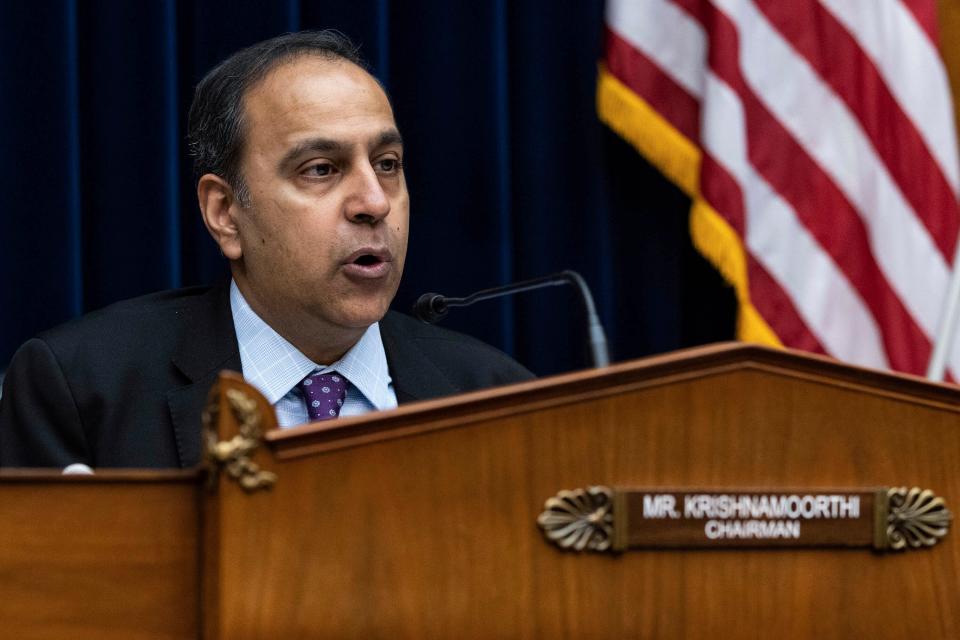EPA should cancel popular Seresto collar over link to pet deaths, congressional subcommittee says

One of the most popular flea and tick collars in America poses “too great a risk to animals and humans” and should be removed from the market, a congressional subcommittee recommended in a report released Wednesday before its hearing titled “Seresto Flea and Tick Collars: Examining Why a Product Linked to More than 2,500 Pet Deaths Remains on the Market.”
The House Subcommittee on Economic and Consumer Policy, part of the House Oversight Committee, the main investigative body in the U.S. House of Representatives, held the hearing Wednesday afternoon to probe the Environmental Protection Agency’s “failure to regulate the Seresto collar as well as Elanco’s refusal to take action to protect pets and their owners from the collar’s harm.”
Six witnesses testified, including the owners of two deceased pets, former EPA scientist and policy analyst Karen McCormack and the environmental health science director for the nonprofit Center for Biological Diversity, Nathan Donley. All spoke against the pet collar.
Jeffrey Simmons, president and CEO of Elanco, the company that manufactures Seresto, called the product safe in his testimony.
"No product is without risk," Simmons told the subcommittee. "What matters is whether those risks are reasonable, in light of the benefits. Numerous studies and the incident report data for Seresto demonstrate the product does not pose an unreasonable risk."
U.S. Rep. Raja Krishnamoorthi, D-Ill., who chairs the panel, launched an investigation into the collar in March 2021 after Investigate Midwest and USA TODAY revealed the high number of incidents related to the collar, as well as the EPA’s inaction despite knowing about the issue for nearly a decade.
“It is unacceptable that the EPA has been aware of the Seresto collar’s safety concerns for years and has continued to allow Americans to unknowingly put their pets in danger by using a product they have been led to believe is safe,” Krishnamoorthi told Investigate Midwest and USA TODAY in a statement before the hearing.

Since it entered the U.S. market in 2012, Seresto has been linked to at least 98,000 adverse incidents and 2,500 pet deaths – the most of any such product regulated by the EPA and the source of internal alarm among some agency employees, records obtained by USA TODAY and Investigate Midwest show.
Elanco said it “unequivocally” stood behind the safety of the collar.
“Numerous studies and the incident report data for Seresto demonstrate the product does not pose an unreasonable risk and has a strong safety profile, which is why the American Veterinary Medical Association opposed canceling Seresto’s EPA registration,” company spokeswoman Keri McGrath Happe said in a statement Wednesday.
In an emailed statement, EPA spokeswoman Melissa Sullivan said the agency is conducting a review of the product, assisted by the Food and Drug Administration, which it expects to wrap up in fall 2022.
“Upon completing its analysis and assessment, EPA will determine whether these pet collar registrations can still be used safely according to the instructions on the label or if additional safety measures or cancellations are needed for these products,” she said.
The EPA did not answer a question about why it did not have anyone scheduled to speak at Wednesday’s hearing.
Elanco has repeatedly defended the collar, its top product, accounting for 8% of revenue annually. The company said the rate of complaints is a fraction of the overall sales – which have surpassed 33 million in the past decade – and that the rate has declined over the years. It said that most incidents are classified as “minor” or “moderate” and that the pet did not suffer “any significant or permanent harm.”
Elanco – which bought the Bayer Animal Health unit, including Seresto, from the German pharmaceutical giant in 2020 for $7.6 billion – said its own extensive studies into the product show that the incidents of harm reported by pet owners are probably related to other factors and not the collar itself.
The subcommittee’s investigation casts doubts on those claims. In a 22-page report that heavily cites reporting and documents published by Investigate Midwest and USA TODAY, as well as never-before-released information, the subcommittee said Seresto “may be the most dangerous flea and tick product on the market” and the EPA has known it for years.
In 2015, the EPA discovered that Seresto had the highest rate of total incidents, as well as death or major incidents, of any such product the agency regulates. “Compared to the second most dangerous product, Seresto had nearly three times the rate of total incidents, and nearly five times the rate of ‘Death’ or ‘Major’ incidents," the report said. "Compared to the third most dangerous product, the Seresto collar had nearly 21 times the rate of total incidents, and over 35 times the rate of ‘Death’ or ‘Major’ incidents."
The report detailed how, in determining whether to approve the sale of Seresto, Canada’s Pest Management Regulatory Agency (PMRA) reviewed data on roughly 1,000 of the most serious death and major pet incidents linked to the collar and found that it “probably or possibly caused 77% of these incidents.” This led the agency in 2016 to deem the collar too dangerous to sell, and PMRA rejected the product’s application even as sales of Seresto continued in the USAs.

Among the cases that PMRA linked to Seresto, the congressional report noted, pets experienced skin problems, “lethargy, abnormal behavior, excessive grooming and vocalization, vomiting, diarrhea, and anorexia.” More than a third of cases involved problems in “multiple organ systems,” and some animals experienced “convulsions, muscle tremors, and loss of control of bodily movements.” Ten percent of those pets died or were euthanized after wearing the collar.
Faye Hemsley fought off tears during the hearing while describing what happened to her dog, Tigger. The Huntingdon, Pennsylvania, resident said that shortly after putting a Seresto collar on Tigger's neck, the dog became lethargic. He died in her son's arms shortly afterward. She said she hoped her testimony could save others from the same fate.
"We miss him every day and the cuddles he gave us," Hemsley said.
Pet owners, too, experienced adverse effects after coming into contact with the collar, according to the congressional report. Symptoms included hives and dermatitis and more serious problems such as “respiratory, neurological, and digestive effects, with throat irritation, breathing difficulty, dizziness, and nausea.”
“Notably, these observed effects on humans were consistent with clinical studies into Imidacloprid – one of the collar’s main active ingredients,” the congressional report said.
The Canadian agency factored in Seresto’s sales data and found that its collars had an incident rate of 36 to 65 incidents per 10,000 collars sold. PMRA considers one incident per 10,000 collars sold as indicative of a potential problem, the report stated. By comparison, 15 pet collars sold in Canada at the time averaged 0.07 incidents per 10,000 collars sold.
“Seresto’s incident numbers were also trending in the wrong direction: PMRA expressed ‘additional concern’ over the fact that Seresto’s total incident numbers had nearly doubled every year since 2013,” according to the congressional report.
The EPA’s peer review of Canada’s analysis “found an even stronger connection between Seresto collar use and deaths,” the report said. The Canadian agency examined 251 pet deaths linked to Seresto and determined that 33% of them were “probably or possibly” caused by the collar. When the EPA independently reviewed the same 251 pet deaths, it “concluded that 45% – or 113 – of the deaths were probably or possibly caused by the collar.”
The EPA did nothing to warn the public and did not require Bayer – or Elanco – to do anything differently to make its product safer or place a warning label on the packaging as Colombia and Australia required, the congressional report noted.
The EPA proposed in 2019 that Bayer separate its registrations for the collar, so there was one for cats and one for dogs, the rationale being that the EPA could better analyze incident data for the different products. Bayer rejected the proposal, citing the administrative burden it would cause. The EPA thanked the company for its consideration and backed down, according to the congressional report.
The EPA asked Bayer to update Seresto’s warning label as it had done in other countries. Germany’s label, for example, notes the collar poses neurological risks; Colombia’s label calls it highly toxic; Australia’s label simply says “POISON.” Bayer and Elanco refused the proposal, and the label remained unchanged, the report said.
At one point in the hearing, Simmons said Elanco would be willing to work with the EPA on science-supported changes to its labeling, but its studies into Seresto show the product is not harmful.
The product’s “value is significant,” he said. “The risk is reasonable.”
That response drew a sharp rebuke from U.S. Rep. Katie Porter, D-California, who was questioning Simmons at the time.
“With all respect, Mr. Simmons, it's not your job to decide if the risk is reasonable. That’s the job of the regulatory body,” Porter said. “My concern is that (Elanco) is standing in the way of allowing the EPA to gather those necessary data and make that necessary decision.
“I encourage Elanco to work with the EPA to get this data, and if they won’t, then Seresto will have to come off the market. Too many families have suffered already.”
Investigation: Popular flea collar linked to almost 1,700 pet deaths. The EPA issued no warning.
The congressional report said documents obtained by the subcommittee “show that Bayer and Elanco relied on dubious justifications to explain adverse incidents caused by the Seresto collar” and called into question their claim about the “Weber effect.”
The Weber effect is a theory that “the number of incidents linked to a product will peak at the end of the second year after regulatory approval, followed by a steady decline as the market becomes familiar with the product,” the report said. When Bayer used this justification during a meeting in July 2019 between the company and the EPA, reported animal deaths had climbed each of the seven years the collar had been on the market.
Elanco said in a statement to USA TODAY and Investigate Midwest that the rate of incident reports has decreased. According to the company's numbers, McGrath Happe said, the rate was 17.26 per 10,000 collars sold in 2021.
"That’s less than a fifth of 1% reporting rate across-the-board," she said. "More than 93% of incident reports received for Seresto pet collars in the U.S. from January 2013 to December 2021 are classified after careful analysis as 'minor' (70.65%) or 'moderate' (22.59%), with the vast majority being redness or irritation at the site of the collar. In analyzing all reports, the data show no established link between the active ingredients in Seresto and pet death."
Krishnamoorthi said Elanco’s science did not pass the smell test when compared to EPA and PMRA findings.
When asked about this discrepancy, Donley said it’s common that a third-party consultant would find different results.
“If you're profiting off of something then you're likely to find it much safer than an independent scientist would,” he said.
In addition to its demands that Elanco voluntarily recall its collar and the EPA cancel the product’s registration, the subcommittee recommended that the EPA change how it collects incident data and allocates resources to investigate incidents.
“Following the subcommittee’s disturbing findings,” Krishnamoorthi said, “I believe the EPA must expand its data collection standards and more strictly follow its scientific review process to ensure that dangerous products are not permitted to stay on the market and threaten the welfare of pets that so many Americans view as family.”
U.S. Rep. Hank Johnson, D-GA., expressed disappointment that the EPA has failed to take action for years, and it was only after the public learned about Seresto’s harms through media reports and a petition to cancel by the Center for Biological Diversity that the EPA took any action.
"When it came to protecting man's best friend, we couldn't count on the EPA," he said.
More coverage of Seresto collars from USA TODAY
Seresto collars: EPA questioned its ability to regulate pet products with pesticides, like Seresto, records show
EPA issues no warning: Popular flea collar linked to almost 1,700 pet deaths. The EPA has issued no warning.
Manufacturer speaks: Maker of Seresto defends flea-and-tick collar amid calls for a ban over safety concerns
Concerns mount: The EPA internally raised concerns about Seresto flea collar for years, new records reveal
PA petitioned: Watchdog group petitions EPA to ban Seresto pet collar after thousands report harm
This article originally appeared on USA TODAY: Seresto flea collar should be pulled after dog deaths, Congress says

